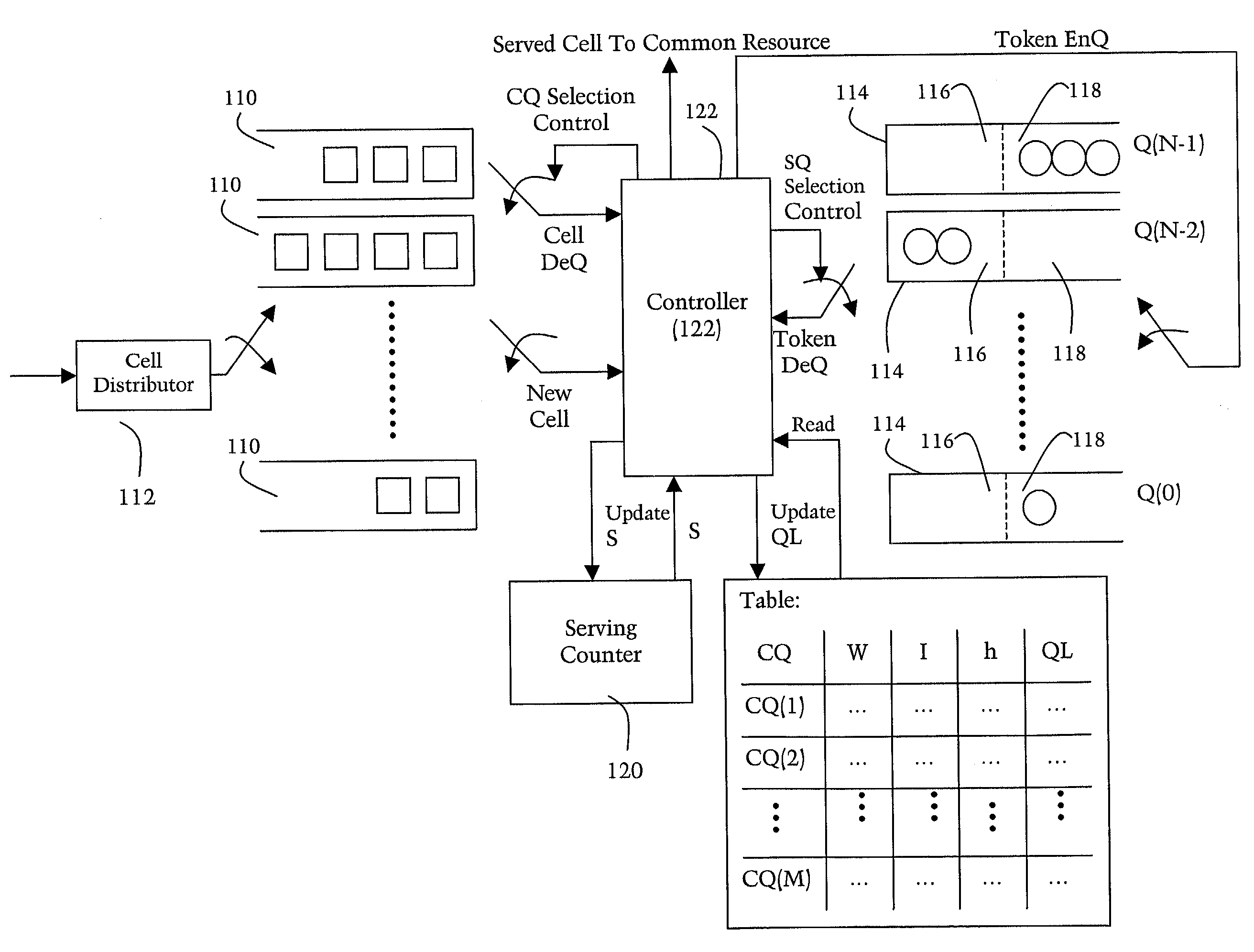Method and apparatus for WFQ scheduling using a plurality of scheduling queues to provide fairness, high scalability, and low computation complexity
- Summary
- Abstract
- Description
- Claims
- Application Information
AI Technical Summary
Benefits of technology
Problems solved by technology
Method used
Image
Examples
example 1
Token Storage / Redistribution
[0107]An example will help illustrate how the token redistribution process is performed using formulas 1 through 5. In this example, we will set N=4 (as shown in FIGS. 9 and 10). CQ(i) will have 4 cells stored therein. When the first cell arrives in CQ(i), a token T(i) will be created therefor and stored in the waiting pool of Q(hi), as described in connection with FIG. 11. The connection weight value Wi for CQ(i) will be Wi=W3iW2iW1iW0i=0111. Thus, as explained in connection with FIG. 10, the eligible scheduling queues for T(i) will be Q(2), Q(1) and Q(0). Under formula 1, hi will calculate out as hi=max{2,1,0}=2 (because W2i, W1i, W0i all equal 1). Thus, T(i) will initially be stored in Q(hi)=Q(2). If we assume T(i) was first placed in Q(2) when S=S3S2S1S0=0101, then at the next update of S to S=0110, Q(2) will be selected (see FIG. 9). When Q(2) is selected, T(i) will be read out of Q(2), and one cell in CQ(i) will be served. Once one cell in CQ(i) is ...
example 2
Token Storage / Redistribution
[0113]In this second example, N will be 4, CQ(i) will have 4 cells stored therein, Wi=Wi3Wi2Wi1Wi0=1010, and T(i) will initially be stored in Q(hi) (as shown in FIG. 11). The value for hi can be calculated according to formula 1 as hi=max{3,1}=3. Thus, T(i) is initially stored in Q(3). The serving value will be 0011. When S=0011, Q(3) is selected, and T(i) will be read therefrom. One cell will be dequeued from CQ(i), leaving CQ(i) backlogged because three cells remain stored therein. Thus, T(i) will be redistributed according to Di.
[0114]The value for ji can be calculated according to formula 4 as:
ji=4−1−max{3,1}=0.
Thus, under formula 3, Ii will be Ii3Ii2Ii1Ii0=0001. Di will be calculated according to formula 2 as Di=S+Ii=0011+0001=0100. Then, p will be calculated according to formula 5 as:
p=4−1−min{2}=1.
Because Wip=Wi1=1, T(i) will be stored in the waiting pool of Q(p)=Q(1).
[0115]S will next be updated to 0100, which results in Q(1) being selected. Becau...
PUM
 Login to View More
Login to View More Abstract
Description
Claims
Application Information
 Login to View More
Login to View More - R&D
- Intellectual Property
- Life Sciences
- Materials
- Tech Scout
- Unparalleled Data Quality
- Higher Quality Content
- 60% Fewer Hallucinations
Browse by: Latest US Patents, China's latest patents, Technical Efficacy Thesaurus, Application Domain, Technology Topic, Popular Technical Reports.
© 2025 PatSnap. All rights reserved.Legal|Privacy policy|Modern Slavery Act Transparency Statement|Sitemap|About US| Contact US: help@patsnap.com



